The Culling Wind
On moving with intention and fixing shit
Apologia: I’ve struggled to find the right words to share these past few weeks, and have drafted about 5,000 of them that didn’t make the cut. I’m not sure if these ones will do, but figured it’d just be best to get them out, whether or not they’re any good, so I can get on with writing about hickories, crawdads, mud, and the like. Not spending much time editing, just pressing “publish” now.
The remnants of recent snow have all but evaporated in warm, late February wind, only a few dusty corpses of piles remain, shrinking in the north shadow of barns and ditches, crumbled and pecked through and scarred by the fork-mark tracks of foraging juncos that flit from standing dead asters to grain laden leavings of swine on the thawing pasture. The warm winds sweep over grids of field fence, blasting tilled earth against creaking, groaning stands of proud hackberry and blighted elm. Red tail hawks cruise over the wind-whipped thatch in search of panicking cottontails, and skeins of snow geese press across the dusty sky with the winds of transition, their wings pumping in a mechanical rhythm.
When the late winter wind is high and the air fills with topsoil from places south and west of here, I do as the deer, and take to the timber, bedding down in the brambles and buck-brush. The stasis of mid-winter has dissipated, and the kindling fire of dormancy creeps out by inches. In these coming weeks, we will press seeds into good earth, cut and inoculate mushroom logs, sow clover and graft pears and haltingly enter the outward photosynthetic cycle, pasturing cows and browsing goats as the fields and draws awaken. We are near kidding season, and the barn will soon hum with bleating goat kids– for now it emits naught but the creak of hinges and the labored breathing of kid-full nannies in late gestation. Every spring, in spite of winter’s deep inertia, birth and germination inevitably make their howling arrival on transitory winds.
To prepare for this storm of regeneration, we must mend, rebuild, and repair the battered infrastructure– a gate pulled off the hinge, and barnyard storm door swept away by wind, the bent and stretched and torn lengths of corroded chicken-wire that stitch through garden soil and prairie sod. We will sharpen shovels and blades, knock wasp nests off the dusty coffee-cans full of mismatched hardware in the tool shed, pry loose t-posts out of the thawing muck and rest the winter loafing yards, allowing the pock-marked patches of mud and hay to sprout fine, tender grasses. Winter’s reserves have been largely consumed, and with the larder half empty we enter into the early hunger gap, the dry and windswept earth offering little more than a few patches of desiccated chickweed.
We’ve slaughtered two wether goats, and I’ve been hunching and creaking over a butcher block in our unfinished outdoor kitchen, sometimes with friends, sometimes alone, trimming sinew and pulling bones from cold red flesh. I work to preserve every scrap and chunk, in brines and cures and plastic bags. The days to cull our flocks and herds are winding down in the awakening of long days and warm wind, so we must move deliberately, and with intention.
For more than a decade, I’ve aspired to produce ethically raised animal foods– more each year. It may be a simplified view, but I don’t see Americans reducing their consumption of animal products. Farming in a place that’s better suited to grass and grazing than most any other crop, I came to the conclusion some time ago that raising these foods with a high degree of compassion and ecological integrity was the best way to affect some meaningful difference. I thought I might be able to hatch some economic model that would find appeal among other farmers in our community, and that they might follow suit and alter their own management for the higher economic margins, if not the greater good. Financially, it has not been a success– and at this moment, the idea of being reliant on a potentially volatile commodity in a new era of austerity and possible bird flu outbreaks seems bleak. I can’t walk away from the needed repairs or the necessary work much longer. I must stand in the culling wind, the wind that sweeps in a strange new season, and as they say, reduce my liabilities.
Culling is one of the many painful practices farmers endure. Orchardists thin abundant young fruits to ensure the health and quality of what remains, gardeners pinch and prune shoots and pull out spare seedlings to die young. And I kill animals– old hens, tough roosters, unassuming wether goats and fat pigs. I do not relish the day of slaughter, but do take some pride in being able to administer a death that is free of pain, stress, and anguish. Day by day I work through carcasses– their tense, rough shanks, rich flesh, dense bones, thick hides and crumbling fat all manifested by soil and rain, sun and grass and browse. I find wonder in the construction of these bodies, as do the nuthatches who defy gravity and peck at their gamey fat which I’ve strung along thorny Osage boughs as a simple offering to the place that gave these goats life and shelter and sustenance– but deeper in, as my hands grow numb in the waning winter sun, I find some pain too.
These culling winds offer a time for consideration, and in many ways I feel stuck. Every year, tens or hundreds of thousands of farmers at my scale go out of business in America. I have not placed an order for turkey poults, and have kept my beloved swine breeding stock separated as to not farrow anymore piglets– I am burning out producing an overpriced product that still cannot support the needs of my household, and too proud to leave behind the only skills I hold. My children need more than I can supply by “feeding the world”. It’s no surprise… I’ve watched these transitory winds billow along the edge of these fields for years, watched the branches bend and snap, now accelerated by the wholesale enclosure of profit for the few, the eroding wind of extraction that guts the last inch of topsoil from the last plow-torn remnants of old prairie. It’s just one of many existential riddles prompted by the reckless, pillaging actions of our ruling class –the failed, ego-mad real estate barons with poor taste, white supremacist tech villains, their hateful, greedy, ignorant leagues of underling yes-men and fund-raising enablers across the aisle. How do we move forward and provide nourishing services and commodities for the generations to come when the future if for sale at a discounted rate? It makes boutique turkeys raised with ecological integrity seem obsolete. Perhaps some culling is in order.
It’s late winter– we cull, and we repair. We fix shit. We move with intention. The pace at which they’re moving is creating justifiable fear in the world over these hills, but the flickers and nuthatches and fat chickadees don’t seem to notice. They hold up their end of the bargain, remaining plump on frozen larvae and sawtooth sunflower seed. Fear only arises in short minutes– fox barks and shrieking Cooper’s hawks. It’s an idle fantasy of mine to live like these birds, completely in my own natural essence, perhaps uncomfortable but otherwise quite fine and hemmed in by the limitations of the surrounding ecology, fearlessly engaged in the meaningful work of merely existing. But for as much as we humans are animals already, we are also the only known species capable of regulating our impact on our surroundings. When not cast into chaos, the cycles of other animals repeat themselves on static loops– they migrate, they nest, they hunt and cache and spawn roe and hibernate and deliver pups. They even create some disturbance too. Bears root through rotting debris in the forest, spreading mycelium. Bison wallow in the dust, creating seed-beds for specialized prairie plant-life, and given the opportunity, beavers will flood vast areas creating the conditions for diverse ecotones. While there is no true stasis to the acts, they can occur at an indefinite rhythm inside a rhythm over millennia, adjusting to change in a glacial time frame. They move slow, they fix things.
Some participants in these ecological communities have organized themselves socially to adapt, and others leverage sticks to aid in gathering food, without disrupting the larger cyclic order. We ourselves might not be so far from the birds and bees and baboons were it not for the terrifying power to outsource labor and meaning through condensed fossil energy. The ability to use tools and manipulate landscapes does not separate us from these systems so much as our intentions and velocity of action. In other words, these people will either escape the planet they broke with the last resources they can wring from it, which I highly doubt, or eventually be run through with pitchforks. Either way, I’ve decided the most important work I can be doing is to help repair and regenerate the models that support complex biotic life. Hopefully humans can be a part of them too.
Moving with intention and fixing things is not impossible for a few people to do on the local level. Just as ecotones morph and shift gradually in response to changing pressures, distinct communities are capable of flexibility and adaptation once their survival becomes more clearly mutualized. We’re living through the death throes of an empire of extraction that cannot attack us on all fronts. Sadly, certain groups of people are absorbing the blunt of this blind violence, and they expect the rest of us to be entertained by these attacks while we’re gradually abandoned altogether. But from the watershed to the continental shelf, I am hopeful that the obvious mutuality of our struggle will grow.
There’s no limit to the things which need triage, repair, and regeneration, and no shortage of passionate or knowledgeable people to do the work. In fact, more and more of them are being fired every day. I think the main resource in demand is functioning cooperative models. These are not the sort of thing that a person just dreams up, they’re created through action and adaptation. For the past two years, I’ve been co-developing an agroforestry collective with neighbors– by which I mean, we plant trees. We’ve been moving with intention and getting shit done. It’s not 100 % fun, but I’d say it’s pretty close to 90%. It takes a certain degree of privilege to access land and resources for these projects, but by working through a land trust, those disadvantaged members of the collective can leverage the privilege of others to gain equitable access. It is my hope that models like these can become spokes in a larger network.*
At an appropriate scale, and with the inherent trust that comes from mutualized survival, a group like ours can operate without much in the way of hierarchy or even a paper trail. We can make like the squirrels and hoard germplasm. We can begin the first steps of developing locally adapted tree crops and the infrastructure to process them, and prepare to disseminate them as things like crop insurance, cheap fuel, and rudimentary rural social services evaporate. Growing food and stewarding land with minimal inputs is maybe the only thing I understand. Other models that meet other needs will require folks with different passions and expertise. We’ve seen examples of adapted human communities form in response to natural disasters and human-derived atrocities throughout time. While we still live in the relatively insulated age of affluence in early decline, the work of forming cooperative groups, pooling resources, and preparing for the work of repair with intention is easier than it’s ever been— the only resource that’s lacking may be that sense of mutuality.
Last night was damn cold. Today is not great. The cold is cumulative, but none of us are dead. While my exposed skin burns in the lightest breeze as I cut through culled goats, there is still some sense of comfort in these predictable, frozen days. I will move carts of resources back and forth. I will chop at icy water troughs with dull axes, and carefully collect the eggs before they freeze. I will cut some wood, and burn it, and in the morning, empty the ash again. I’m keeping up my end of the bargain, and waiting for the right time to do what I know best. The work is consistent and simple and takes twice as long as usual. The seeds of next year’s trees are still dormant, sleeping in the stony embrace of frozen clay for now. Our garden seeds are in the mail, and so long as there’s still a postal service in the next few weeks, we’ll probably get them. While there is much cause for concern in the world just over these icy hills, I cannot make it that far from home today.
Soon, the drip-drop of melting icicles, the moaning cracked plates of the pond, and the intensifying orchestra of dawn birdsongs will all grow louder– as the puddles form, as the mud flows, as frost-bit patches of nettle and dandelion grow green once more. The old rhythms are not lost. Seeds will keep sprouting and their roots will throb with new life in the cold mud, and we will protect them, because right now, we need each other to survive. The cold is cumulative but it does end. That’s when the repair begins.
* I’ve wanted to, and am planning to address the drier, technical aspects of starting agricultural collectives and co-ops, but haven’t found the inspiration to sit down and make it happen yet. Many readers have asked for it, and I will address this question soon, in either written form or some type of live chat, if I can handle the stress of performing.


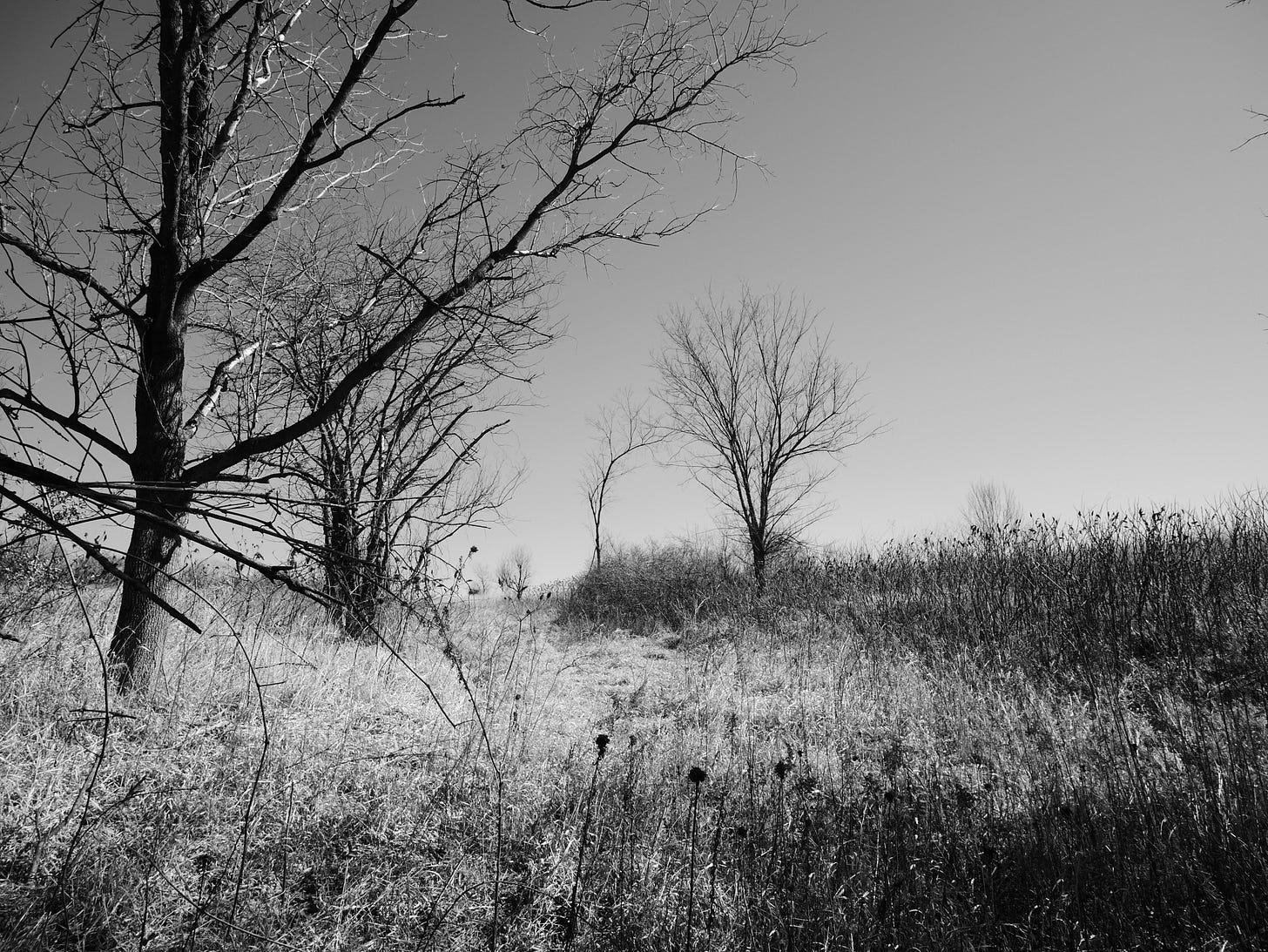
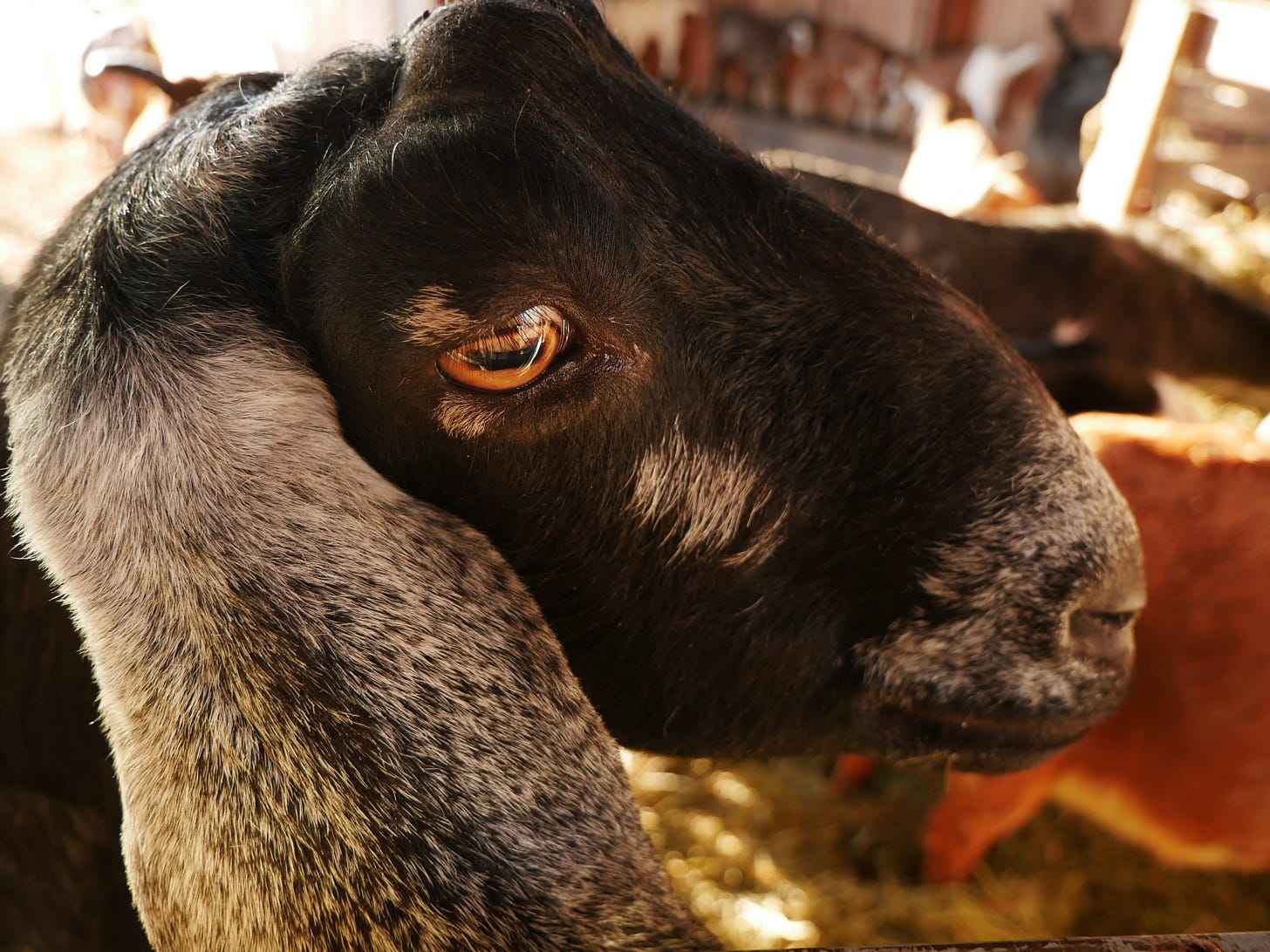
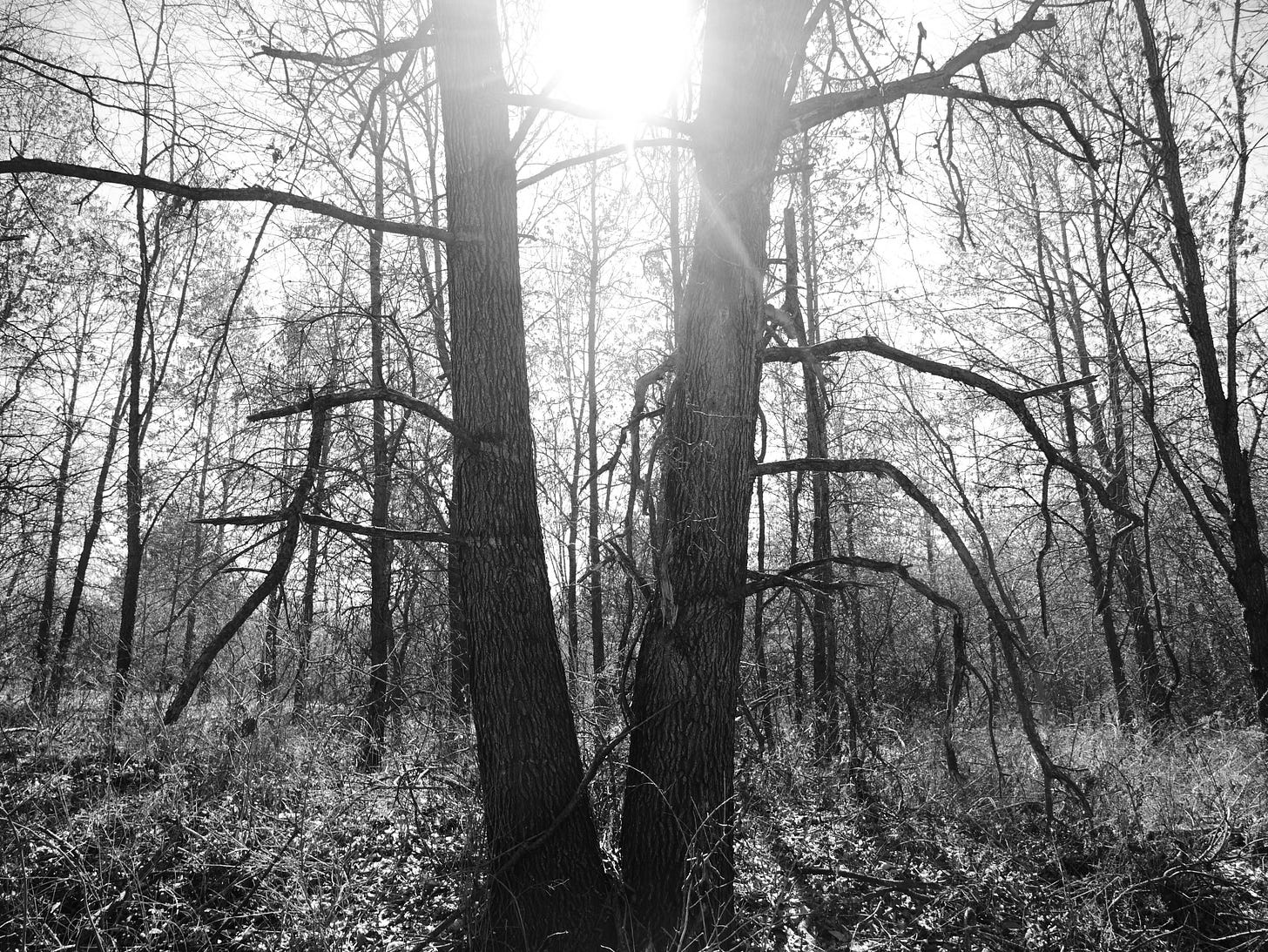
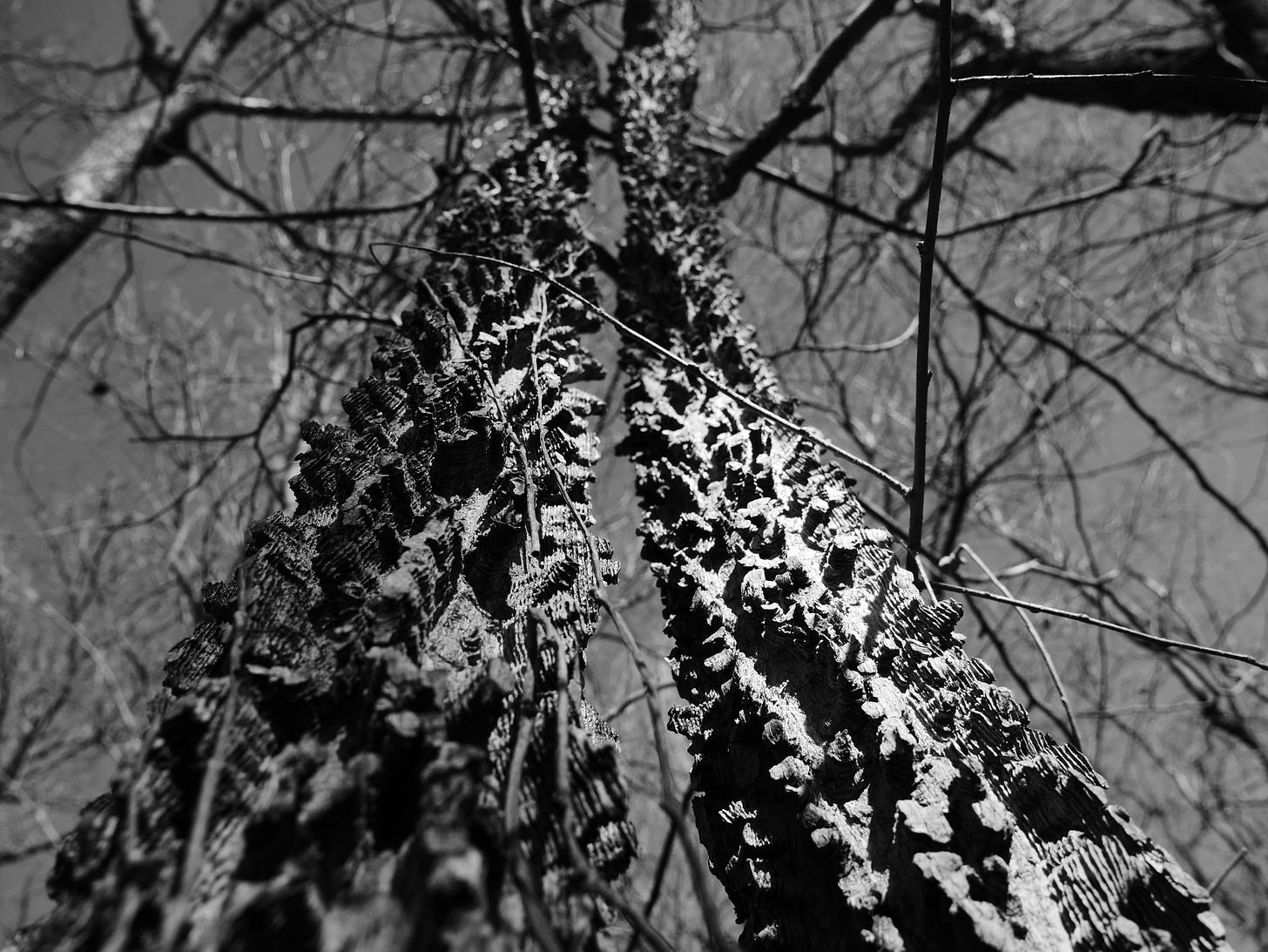
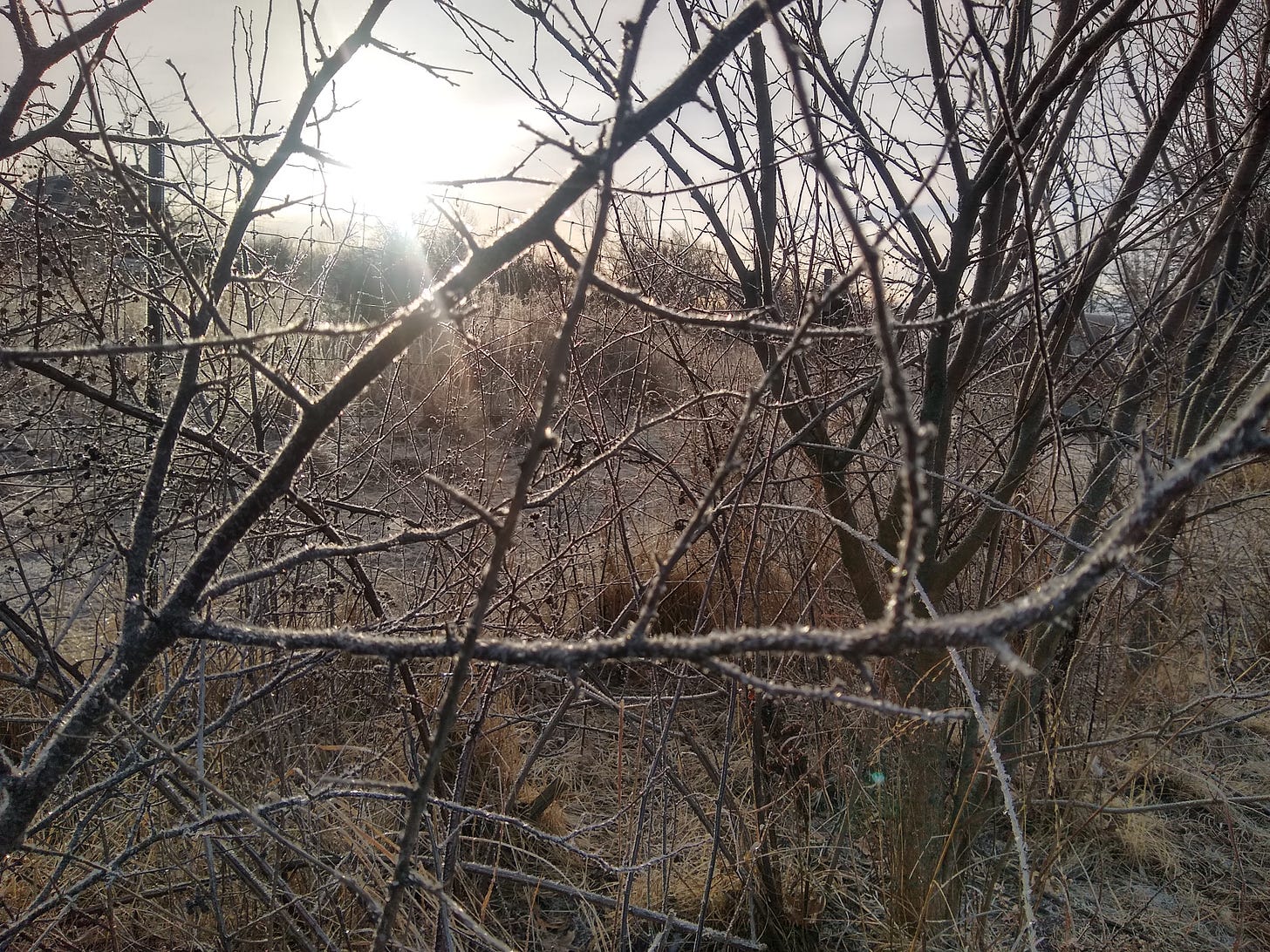
That is a very beautiful goat! It is those old rhythms and cycles that can anchor us when the human world is in an uproar. Your efforts to grow an agroforestry community are hopeful, caring, kind and pragmatic too for humans and the land. If only more of us planted trees native to our places, and took care of the land as you try to do. Every year I tend to my small urban yard of native plants, shrubs and trees, making a tiny difference for wildlife, and it rewards my efforts many times over with the meaning, purpose and sense of hope it brings to my days. x
The need for community support and engagement you touch on is critical to developing food systems that maintain soil health and healthy people. In a reduction, I'd say the modern focus on the individual at the expense of family and community has given us declining health, too much corn and soy and the inability to sustain diversified small and medium scale farming. Every time I hear someone talk about lower prices on food at Walmart my hopes die a little more. I read recently that American's spend 6% of their income on food today, when not that long ago it was 25%. 20% of meals are eaten in the car and probably 90% of those are eaten alone. Well, for my part I teach foraging, cooking and eating to groups and families...and I hope they decide that while family time and community time producing, preparing and eating food may seem like chores/work, they really are the foundation for happy and healthy families and communities. Thank you for your thoughts.